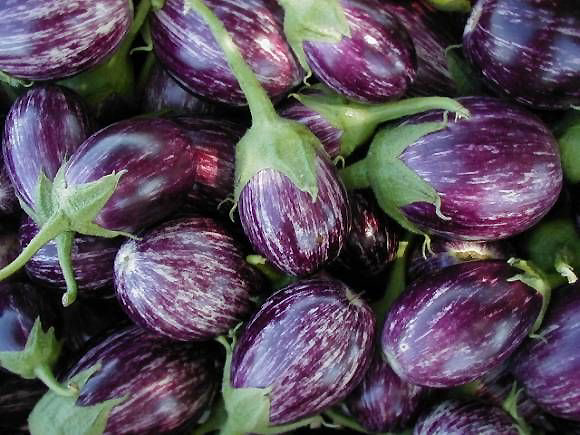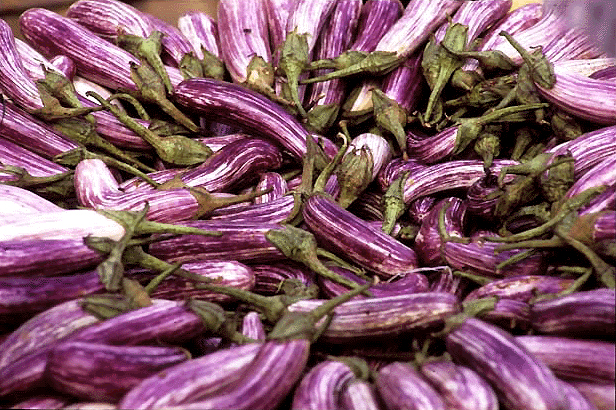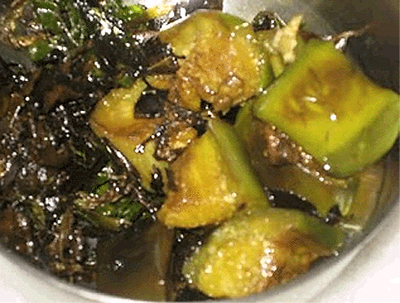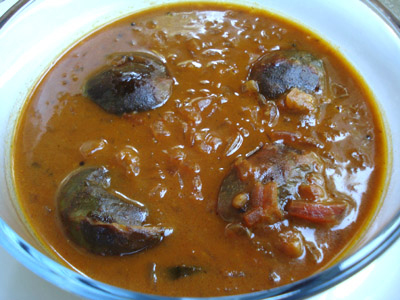
|
|
|
|
BY: SUN STAFF
 Jun 29, 2010 — CANADA (SUN) — A journey through India: border to border, bhoga to prasadam. Brinjal, or eggplant, is one of the oldest known vegetables to be cultivated by man. This truly Indian vegetable is well documented as having originated in India, traveling from there to nearly all parts of the globe. Today it stands as a unique example of the historical progression of foodstuffs: this ancient vegetable is now at the center of a firestorm, as modern science battles traditionalists in their effort to introduce genetically modified brinjals to the Indian market. As we'll read in a later segment, their efforts are fortunately being met with great resistance.
Perhaps because of their longevity in the vegetable family, brinjals are known by a great many names. They belong to the Solanaceae family of 'deadly nightshades', along with the tomato and potato. This designation refers to a mild level of toxicity found in the vegetable, which has resulted over the ages in certain inhibitions to eating them. While there are various brahminical injunctions against eating brinjals, there are also a great many examples in sastra of brinjal being enjoyed by Sri Krsna, Lord Caitanya, and other transcendental personalities. We'll explore this aspect in more detail in tomorrow's next segment. In Sanskrit, names for the brinjal include bhantaki, darada, jukutam, hingoli, vartaka, vartaku, vrutaka, vaantaki, vantika, and vatinganah. Vartaku is considered to be a pre-Sanskrit word, derived from the ancient Mundas (Austrics) language, one of the oldest in India, now extant in Jharkhand region only, for the most part. Many of the names used today can be traced back to the Sanskrit vatin-ganah. In Persia, brinjals are badin-gan, which evolved into the Arabic albadinjan. As the brinjal reached Spain, then Europe, it's name eventually came into the French aubergine, which is popularly used in the west today, along with 'eggplant'. There are countless other names for the brinjal, many of which refer to its egg-like shape. In India, as with most foodstuffs, there are numerous regional words for eggplant. In Tamil, the term kathirikai refers to its purple color. It's called pathiyakari (pathiyam means 'diet') because it is an excellent food for certain restrictive diets. In Hindi it is begun, and in Bengali, ringni, vengni, and vantak.

By whatever name we call it, the brinjal is an excellent foodstuff. Although the taste is somewhat mild, it has a delicious nutty flavour and is a great medium for absorbing other flavors. Brinjal is also valued for its texture, which can be employed to get so many different types of dishes. In this segment of the Prasadam series, we'll offer recipes for brinjals that are stuffed, baked, deep fried, roasted, puréed and even candied, in rice dishes, dahls, sabjis, savouries, raitas, chutneys, and sweets. We have heard that Srila Prabhupada once remarked, 'brinjal is just an excuse to eat ghee'. This certainly describes one of the essential and wonderful qualities of the vegetable. Unless deep-fried in very hot ghee, brinjal tends to cook slowly, being very absorbent of ghee or other cooking juices. This quality can be nicely employed in sabjis, or avoided in favor of a more crispy quick-fried item. There are many wonderful references in sastra to preparations made with brinjals. They are mentioned in the Ramayana, various Buddhist and Jain sutras, and ancient Tamil literature. The Vaisnava poet Krishnadasa wrote about brinjals in his Krishna-mangala (c. 1525), in which he listed various foods prepared by the gopis and gopas of Vrindavan for Sri Krsna. The earliest known travelogue written in Sanskrit is the Tirtha Prabandha, by the saint Vadiraja, of the Madhva line, who traveled extensively on tirtha-yatra across India. A contemporary of Lord Caitanya's, Vadiraja's travels included a visit to Navadvipa. He writes about some of the feasts offered to Mahaprabhu there by the devotees, including "shali rice drenched in yellow ghee, surrounded by leaf cups, dhal, sag, and vegetables like . . . the brinjal". In Sri Caitanya-caritamrta, Madhya lila, we read that brinjal was among the foodstuffs Advaita Acarya offered to Sri Caitanya: Madhya 3.47:
"Amongst the various vegetables were newly grown leaves of nimba trees fried with eggplant. The fruit known as patola was fried with phulabadi, a kind of dhal preparation first mashed and then dried in the sun. There was also a preparation known as kusmanda-manacaki." About this preparation for neem leaves fried with brinjal ( vartaki), in his purport Srila Prabhupada states, "We request our editors of cookbooks to add all these nice preparations described by the experienced author Srila Kaviraja Gosvami. Later in Madhya lila, we read about the opulent foodstuffs offered to Lord Caitanya in the home of Sarvabhauma Bhattacarya, who built a new lunchroom just for Mahaprabhu to take prasadam in. The same preparation was offered, of nimba (neem) leaves fried together with eggplant. Madhya 15.213
"Other preparations included eggplant mixed with newly grown nimba leaves fried together, light badi, fried patola and fried rounds of squash and pumpkin." In the Antya lila of Caitanya-caritamrta we read of another brinjal preparation, nimba-vartaki, offered to the Lord by Advaita Acarya. This one features neem flowers rather than leaves: Antya 10.135-136
"They offered pungent preparations made with black pepper, sweet-and-sour preparations, ginger, salty preparations, limes, milk, yogurt, cheese, two or four kinds of spinach, soup made with bitter melon, eggplant mixed with nimba flowers, and fried patola." In all three of the preparations mentioned above, brinjals have been paired with nimba (neem), a bitter food, and the two are fried, most likely in ghee or mustard oil. As mentioned above, brinjals are particularly absorbent of other flavors, making them a perfect pair for bitters like neem or karela (bitter melon), which are mellowed by combining with the mild nuttiness of eggplant. It is interesting, however, that brinjals are a member of the deadly nightshade family, and that they combine so well with bitters. This may indicate a natural affinity between the types of foodstuffs. In Ayurveda, the combination of neem and brinjal is considered bitter (tikta and astringent (kashya), with a light quality and pungent post-digestive effect. The preparation increases digestive fire, thus it's typically eaten as a starter.

Neem Begun

Brinjal Tamarind Curry
| |